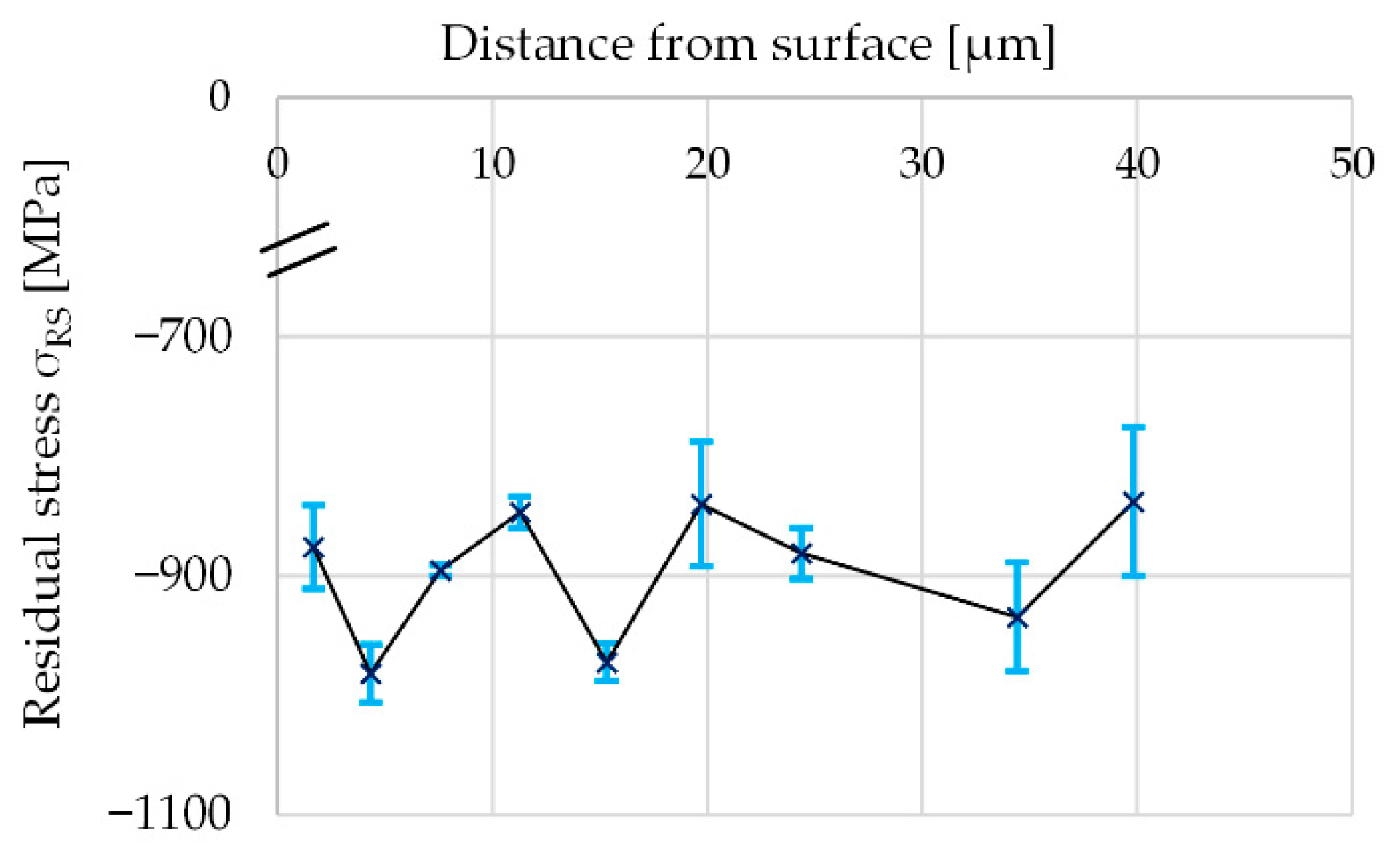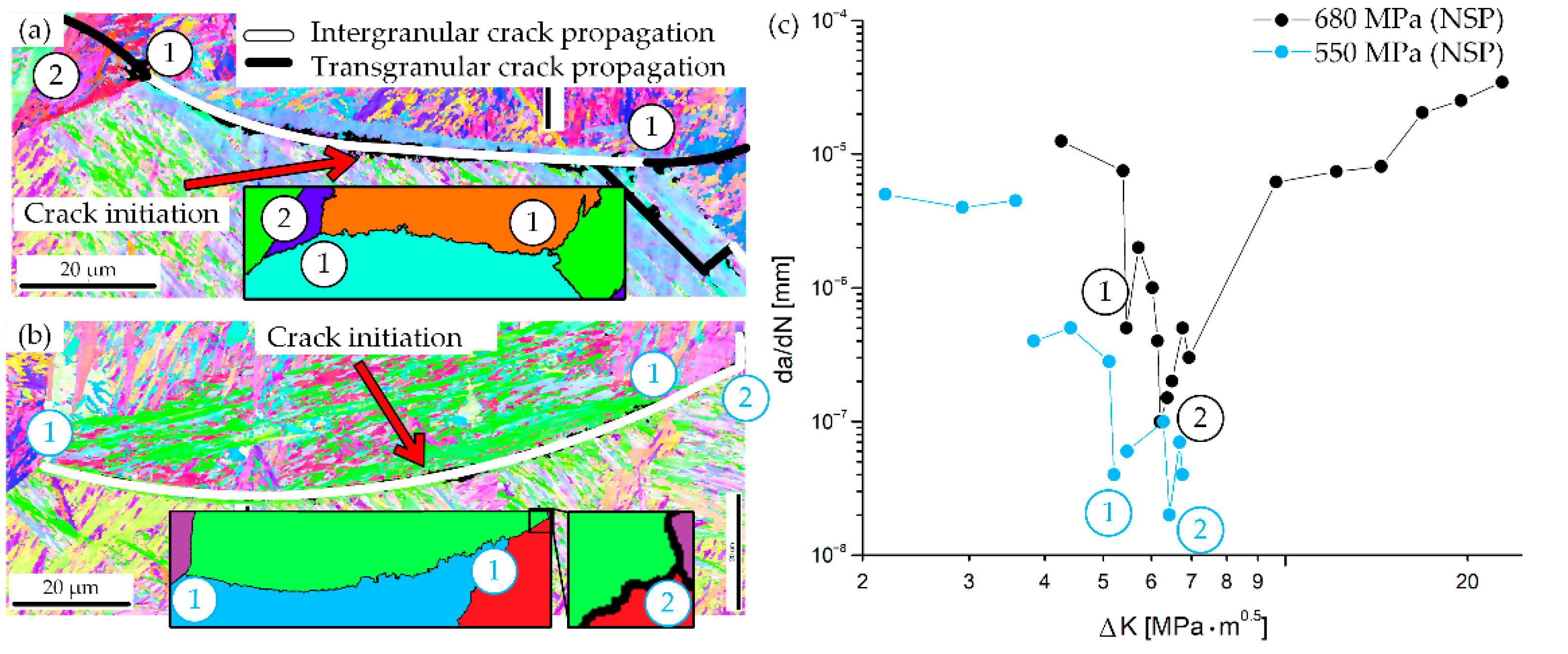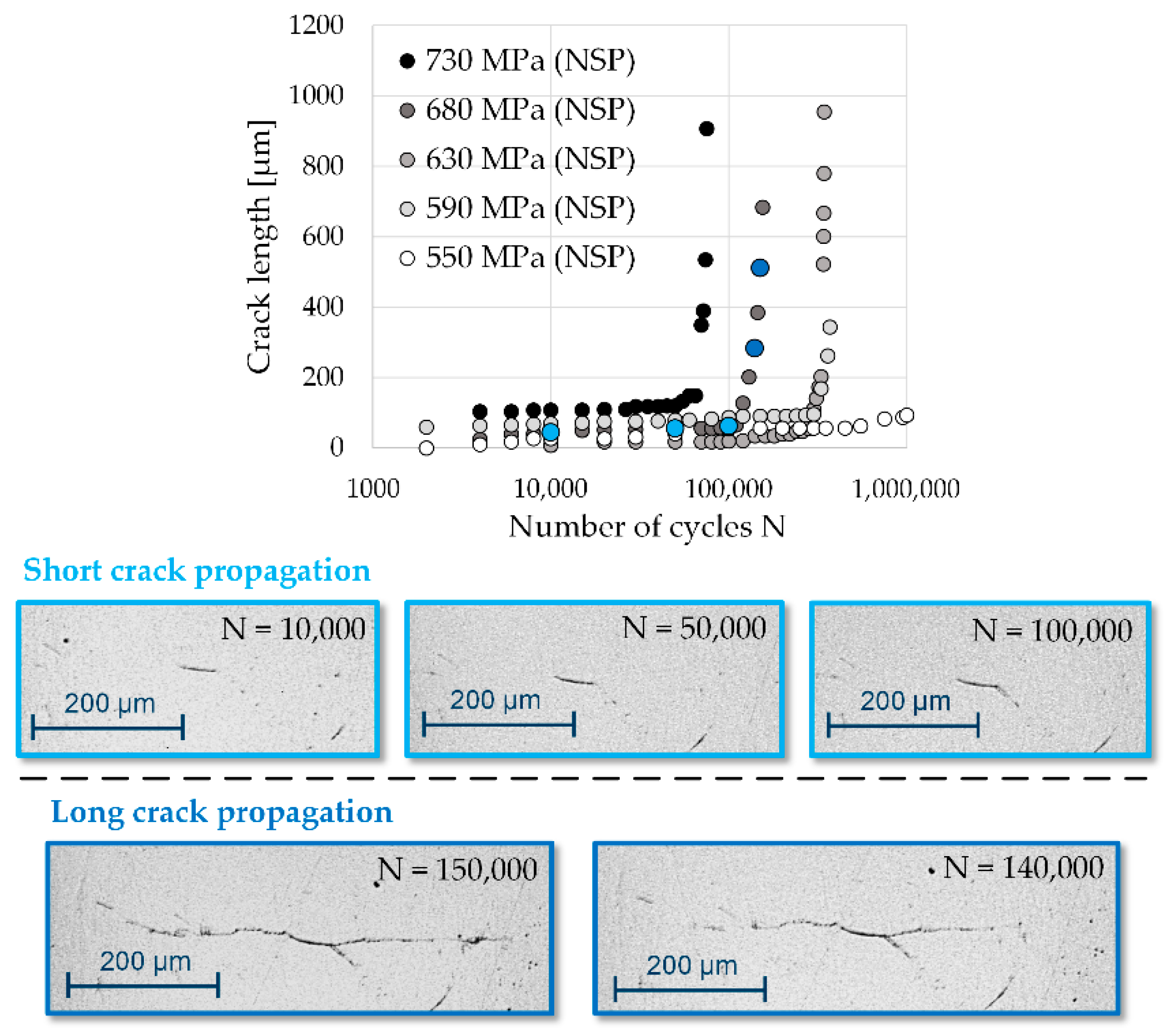Influence of Residual Stresses on the Crack Initiation and Short Crack Propagation in a Martensitic Spring Steel
Abstract
:1. Introduction
2. Material and Methods
2.1. Material and Sample Geometry
2.2. Shot Peening and Residual Stress Measurement
2.3. Testing Strategy
2.4. Short Crack Growth Monitoring and Microstructural Characterization
3. Results
3.1. Microstrucuture and Residual Stress Profile
3.2. Crack Initiation
3.3. Short Crack Propagation
4. Discussion
5. Conclusions
- In the first stage of the fatigue tests, which were carried out in the HCF regime, the early fatigue damage in both sample conditions was characterized by the formation of numerous slip bands on the sample surface. These slip plane traces followed the local crystallographic orientations of the martensitic laths. In the slip bands, the cyclic plastic deformation occurred localized, leading to crack initiation. Hence, a network of short cracks formed all over the sample surface.
- The crack density was applied as a parameter for fatigue damage. It was shown that the value of this parameter increased in both sample conditions continuously with increasing number of cycles and that this increase was more pronounced the higher the stress amplitude applied. Regarding the effect of residual stresses on the evolution of crack density, a comparatively lower crack density in the case of the SP samples was observed, especially when a higher number of cycles was concerned.
- In both sample conditions, most of the slip bands and, correspondingly, most of the short fatigue cracks initiated at or close to prior austenite grain boundaries. The subsequent early short crack propagation occurred primarily in an intergranular manner along the prior austenite grain boundaries.
- A detailed analysis of the local short crack propagation rate in correlation with the local microstructure revealed an oscillating crack propagation rate, resulting from a strong interaction of the short fatigue cracks with microstructural features. In this process, the PAGBs were identified to act as obstacles to short crack propagation due to a change in the crystallographic orientation. This relation arose irrespectively of whether the sample surface contained compressive residual stresses or not.
- The SP samples exhibited a higher fatigue life as compared to the NSP samples. It is assumed that this beneficial effect of compressive residual stresses is due to the impediment of the transition from short crack propagation into long crack propagation on the sample surface and a shift of the fatal crack initiation from the sample surface to the interior of the material.
Author Contributions
Funding
Data Availability Statement
Acknowledgments
Conflicts of Interest
References
- Christ, H.-J. (Ed.) Ermüdungsverhalten Metallischer Werkstoffe, 2nd ed.; Wiley-VCH: Weinheim, Germany, 2009. [Google Scholar]
- Totten, G.; Howes, M.; Inoue, T. (Eds.) Handbook of Residual Stress and Deformation of Steel; ASM International: Materials Park, OH, USA, 2002. [Google Scholar]
- Eleiche, A.M.; Megahed, M.M.; Abd-Allah, N.M. The shot-peening effect on the HCF behavior of high-strength martensitic steels. J. Mater. Process. Technol. 2001, 113, 502–508. [Google Scholar] [CrossRef]
- Almer, J.D.; Cohen, J.B.; Winholtz, R.A. The effects of residual macrostresses and microstresses on fatigue crack propagation. Metall. Mater. Trans. A 1998, 29A, 2127–2136. [Google Scholar] [CrossRef]
- Stacey, A.; Webster, G.A. Fatigue crack growth in autofrettaged thick-walled high pressure tube material. MRS Online Proc. Libr. 1984, 22, 215–219. [Google Scholar] [CrossRef]
- Miller, K.J. The Behaviour of short fatigue cracks and their initiation, Part I—A review of the two recent books. Fatigue Fract. Eng. Mater. Struct. 1987, 10, 75–91. [Google Scholar] [CrossRef]
- McEvily, A.J. The growth of short fatigue cracks: A review. Trans. Eng. Sci. 1996, 13, 93–107. [Google Scholar]
- Efthymiadis, P.; Pinna, C.; Yates, J.R. Fatigue crack initiation in AA2024: A coupled micromechanical testing and crystal plasticity study. Fatigue Fract. Eng. Mater. Struct. 2019, 42, 321–338. [Google Scholar] [CrossRef] [Green Version]
- Hong, Y.; Gu, Z.; Fang, B.; Bai, Y. Collective evolution characteristics and computer simulation of short fatigue cracks. Philos. Mag. A 1997, 75, 1517–1531. [Google Scholar] [CrossRef]
- Miller, K.J. The short crack problem. Fatigue Fract. Eng. Mater. Struct. 1982, 5, 223–232. [Google Scholar] [CrossRef]
- Yang, M.; Zhong, Y.; Liang, Y.-I. Competition mechanisms of fatigue crack growth behavior in lath martensitic steel. Fatigue Fract. Eng. Mater. Struct. 2018, 41, 2502–2513. [Google Scholar] [CrossRef]
- Kitahara, H.; Ueji, R.; Tsuji, N.; Minamino, Y. Crystallographic features of lath martensite in low-carbon steel. Acta Mater. 2006, 54, 1279–1288. [Google Scholar] [CrossRef]
- Koschella, K.; Krupp, U. Investigations of fatigue damage in tempered martensitic steel in the HCF regime. Int. J. Fatigue 2019, 124, 113–122. [Google Scholar] [CrossRef]
- Brückner-Foit, A.; Huang, X. On the determination of material parameters in crack initiation laws. Fatigue Fract. Eng. Mater. Struct. 2008, 31, 980–988. [Google Scholar] [CrossRef]
- Bertsch, J.; Möslang, A.; Riesch-Oppermann, H. Fatigue crack initiation in a ferritic-martensitic steel under irradiated and unirradiated conditions. In ECF 12; Engineering Materials Advisory Services Ltd.: Sheffield, UK, 1998. [Google Scholar]
- Nishikawa, H.-A.; Furuya, Y.; Igi, S.; Goto, S.; Briffod, F.; Shiraiwa, T.; Enoki, M.; Kasuya, T. Effect of microstructure of simulated heat-affected zone on low- to high-cycle fatigue properties of low-carbon steels. Fatigue Fract. Eng. Mater. Struct. 2020, 43, 1239–1249. [Google Scholar] [CrossRef]
- Batista, M.N.; Marinelli, M.C.; Alvarez-Armas, I. Effect of initial microstructure on surface relief and fatigue crack initiation in AISI 410 ferritic-martensitic steel. Fatigue Fract. Eng. Mater. Struct. 2019, 42, 61–68. [Google Scholar] [CrossRef]
- Giertler, A.; Söker, M.; Dönges, B.; Istomin, K.; Ludwig, W.; Pietsch, U.; Fritzen, C.-P.; Christ, H.-J.; Krupp, U. The significance of local plasticity for the crack initiation process during very high cycle fatigue of high strength steels. Procedia Mater. Sci. 2014, 3, 1353–1358. [Google Scholar] [CrossRef] [Green Version]
- Seidametova, G.; Vogt, J.-B.; Serre, I.P. The early stage of fatigue crack initiation in a 12%Cr martensitic steel. Int. J. Fatigue 2017, 106, 38–48. [Google Scholar] [CrossRef]
- Krupp, U.; Giertler, A.; Koschella, K. Microscopic damage evolution during very-high-cycle fatigue (VHCF) of tempered martensitic steel. Fatigue Fract. Eng. Mater Struct. 2017, 40, 1731–1740. [Google Scholar] [CrossRef]
- Motoyashiki, Y.; Brückner-Foit, A.; Sugeta, A. Investigation of small crack behaviour under cyclic loading in a dual phase steel with a FIB tomography technique. Fatigue Fract. Eng. Mater Struct. 2007, 30, 556–564. [Google Scholar] [CrossRef]
- Ueki, S.; Mine, Y.; Takashima, K. Microstructure-sensitive fatigue crack growth in lath martensite of low carbon steel. Mater. Sci. Eng. A 2020, 773, 138830. [Google Scholar] [CrossRef]
- Krupp, U. Fatigue Crack Propagation in Metals and Alloys: Microstructural Aspects and Modelling Concepts; Wiley-VCH: Weinheim, Germany, 2007. [Google Scholar]
- Ohmura, T.; Minor, A.M.; Stach, E.A.; Morris, J.W. Dislocation–Grain boundary interactions in martensitic steel observed through in situ nanoindentation in a transmission electron microscope. J. Mater. Res. 2004, 19, 3626–3632. [Google Scholar] [CrossRef]
- Choi, S. Optimization of Microstructure and Properties of High Strength Spring Steel. Ph.D. Thesis, Delft University of Technology, Delft, The Netherlands, 2011. [Google Scholar]
- Krauss, G. Martensite in steel: Strength and structure. Mater. Sci. Eng. A 1999, 273, 40–57. [Google Scholar] [CrossRef]
- Hayakawa, M.; Matsuoka, S.; Tsuzaki, K. Microstructural analyses of grain boundary carbides of tempered martensite in medium-carbon steel by atomic force microscopy. Mater. Trans. 2002, 43, 1758–1766. [Google Scholar] [CrossRef] [Green Version]
- Horn, R.M.; Ritchie, R.O. Mechanisms of tempered martensite embrittlement in low alloy steels. Metall. Mater. Trans. A 1978, 9A, 1039–1053. [Google Scholar] [CrossRef]
- Briant, C.L.; Banerji, S.K. The fracture behavior of quenched and tempered manganese steels. Metall. Mater. Trans. A 1982, 13, 827–836. [Google Scholar] [CrossRef]
- Bandyopadhyay, N.; McMahon, C.J., Jr. The micro-mechanisms of tempered martensite embrittlement in 4340-type steels. Metall. Mater. Trans. A 1983, 14, 1313–1325. [Google Scholar] [CrossRef]
- Ohtani, H.; McMahon, C.J., Jr. Modes of fracture in temper embrittled steels. Acta Metall. 1975, 23, 377–386. [Google Scholar] [CrossRef]
- Hoseiny, H.; Caballero, F.G.; San Martin, D.; Capdevilla, C. The influence of austenization temperature on the mechanical properties of a prehardened mould steel. Mater. Sci. Forum. 2012, 706, 2140–2145. [Google Scholar] [CrossRef]
- Przybyla, C.; Prasannavenkatesan, R.; Salajegheh, N.; McDowell, D.L. Microstructure-sensitive modeling of high cycle fatigue. Int. J. Fatigue 2010, 32, 512–525. [Google Scholar] [CrossRef]
- Morrison, D.J.; Moosbrugger, J.C. Effects of grain size on cyclic plasticity and fatigue crack initiation in nickel. Int. J. Fatigue 1998, 19, 51–59. [Google Scholar] [CrossRef]
- Christ, H.-J.; Düber, O.; Fritzen, C.-P.; Knobbe, H.; Köster, P.; Krupp, U. Propagation behaviour of microstructural short fatigue cracks in the high-cycle fatigue regime. Comput. Mater. Sci. 2009, 46, 561–565. [Google Scholar] [CrossRef]
- Kolyshkin, A.; Zimmermann, M.; Kaufmann, E.; Christ, H.-J. Untersuchung der Rissinitiierung und -ausbreitung mittels Fernfeldmikroskop im VHCF-Bereich. In Werkstoffprüfung; Christ, H.-J., Ed.; Stahleisen GmbH: Düsseldorf; Germany, 2013. [Google Scholar]
- Manonukul, A.; Dunne, F.P.E. High- and low-cycle fatigue crack initiation using polycrystal plasticity. Proc. R. Soc. Lond. Ser. A 2004, 460, 1881–1903. [Google Scholar] [CrossRef]
- Meyer, S.; Brückner-Foit, A.; Möslang, A. A stochastic simulation model for microcrack initiation in a martensitic steel. Comput. Mater. Sci. 2003, 26, 102–110. [Google Scholar] [CrossRef]
- Leguinagoicoa, N.; Albizuri, J.; Larranaga, A. Fatigue improvement and residual stress relaxation of shot-peened alloy steel DIN 34CrNiMo6 under axial loading. Int. J. Fatigue 2022, 162, 1007006. [Google Scholar] [CrossRef]
- Branco, R.; Costa, J.D.; Berto, F.; Kotousov, A.; Antunes, F.V. Fatigue crack initiation behaviour of notched 34CrNiMo6 steel bars under proportional bending-torsion loading. Int. J. Fatigue 2020, 130, 105268. [Google Scholar] [CrossRef]
- Doquet, V. Crack initiation mechanisms in torsional fatigue. Fatigue Fract. Engng Mater. Struct. 1997, 20, 227–235. [Google Scholar] [CrossRef]
- Korn, M.; Rohm, T.; Lang, K.H. Influence of near-surface stress gradients and strength effect on the very high cycle fatigue behavior of 42CrMo4 Steel. In Fatigue of Materials at Very High Numbers of Loading Cycles; Christ, H.-J., Ed.; Springer Spektrum: Wiesbaden, Germany, 2018; pp. 233–252. [Google Scholar]
- Liu, W.; Dong, J.; Zhang, P.; Zhai, C.; Ding, W. Effect of shot peening on surface characteristics and fatigue properties of T5-treated ZK60 Alloy. Mater. Trans. 2009, 50, 791–798. [Google Scholar] [CrossRef] [Green Version]
- Ludian, T.; Wagner, L. Mechanical surface treatments for improving fatigue behavior in titanium alloys. Adv. Mater. Sci. Eng. 2008, 8, 44–52. [Google Scholar] [CrossRef] [Green Version]
- Starker, P.; Wohlfahrt, H.; Macherauch, E. Subsurface crack initiation during fatigue as a result of residual stresses. Fatigue Fract. Eng. Mater. Struct. 1979, 1, 319–327. [Google Scholar] [CrossRef]
- Tange, A.; Takahashi, F. Fatigue strength and shot-peening. In Proceedings of the ICSP-10, Tokio, Japan, 15–18 September 2008; p. 2008080. [Google Scholar]
- Mlikota, M.; Schmauder, S.; Dogahe, K.; Bozic, Z. Influence of local residual stresses on fatigue crack initiation. Procedia Struct. Integr. 2021, 31, 3–7. [Google Scholar] [CrossRef]
- Lindemann, J.; Buque, C.; Appel, F. Effect of shot peening on fatigue performance of a lamellar titanium aluminide alloy. Acta Mater. 2006, 54, 1155–1164. [Google Scholar] [CrossRef]
- Bag, A.; Delbergue, D.; Levesque, M.; Bocher, P.; Brochu, M. Study of short crack growth in shot peened 300M steel. In Proceedings of the ICSP-13, Montreal, QC, Canada, 18–21 September 2017. [Google Scholar]
- Mutoh, Y.; Fair, G.H.; Noble, B.; Waterhouse, R.B. The effect of residual stresses induced by shot-peening on fatigue crack propagation in two high strength aluminium alloys. Fatigue Fract. Engng Mater. Struct. 1987, 10, 261–272. [Google Scholar] [CrossRef]
- Aviles, A.; Aviles, R.; Albizuri, J.; Pallares-Santasmartas, A.R. Effect of shot-peening and low-plasticity burnishing on the high-cycle fatigue strength of DIN 34CrNiMo6 alloy steel. Int. J. Fatigue 2019, 119, 338–354. [Google Scholar] [CrossRef]
- De los Rios, E.R.; Walley, A.; Milan, M.T.; Hammersley, G. Fatigue crack initiation and propagation on shot-peened surfaces in A316 stainless steel. Int. J. Fatigue 1995, 17, 493–499. [Google Scholar] [CrossRef]
- Berns, H.; Weber, L. Fatigue progress in shot-peened surface layers. In Proceedings of the ICSP-3, Garmisch-Partenkirchen, Germany, 12–16 October 1987. [Google Scholar]
- Misumi, M.; Ohkubo, M. Deceleration of small crack growth by shot-peening. Int. J. Mater. Prod. Technol. 1987, 2, 36–47. [Google Scholar]
- Gao, Y.K.; Wu, X.R. Experimental investigation and fatigue life prediction for 7475-T7351 aluminum alloy with and without shot peening-induced residual stresses. Acta Mater. 2011, 59, 3737–3747. [Google Scholar] [CrossRef]
- Deng, X.; Lu, F.; Cui, H.; Tang, X.; Li, Z. Microstructure correlation and fatigue crack growth behavior in dissimilar 9Cr/CrMoV welded joint. Mater. Sci. Eng. A 2016, 651, 1018–1030. [Google Scholar] [CrossRef]
- Li, S.; Zhu, G.; Kang, Y. Effect of substructure on mechanical properties and fracture behavior of lath martensite in 0.1C-1.1Si-1.7Mn steel. J. Alloys Compd. 2016, 675, 104–115. [Google Scholar] [CrossRef]
- Krupp, U.; Düber, O.; Christ, H.-J.; Künkler, B.; Schick, A.; Fritzen, C.-P. Application of the EBSD technique to describe the initiation and growth behaviour of microstructurally short fatigue cracks in a duplex steel. J. Microsc. 2004, 213, 313–320. [Google Scholar] [CrossRef]
- Farrahi, G.H.; Majzoobi, G.H.; Hosseinzadeh, F.; Harati, S.M. Experimental evaluation of the effect of residual stress field on crack growth behaviour in C(T) specimen. Eng. Fract. Mech. 2006, 73, 1772–1782. [Google Scholar] [CrossRef]
- Tange, A.; Takamura, N. Relation between shot-peening residual stress distribution and fatigue crack propagation life in spring steel. Trans. Jpn. Soc. Mech. Eng. 1991, 36, 47–53. [Google Scholar] [CrossRef] [Green Version]
- Hu, Y.; Cheng, H.; Yu, J.; Yao, Z. An experimental study on crack closure induced by laser peening in pre-cracked aluminum alloy 2024-T351 and fatigue life extension. Int. J. Fatigue 2020, 130, 105232. [Google Scholar] [CrossRef]
- Liehr, A.; Zinn, W. Energy-dispersive residual stress analysis under laboratory conditions: Concept for a new type of diffractometer. Adv. Mater. Res. 2014, 996, 192–196. [Google Scholar] [CrossRef]
- Liehr, A.; Zinn, W.; Degener, S.; Scholtes, B.; Niendorf, T.; Genzel, C. Energy resolved residual stress analysis with laboratory X-ray sources. HTM J. Heat Treatm. Mat. 2017, 72, 115–121. [Google Scholar] [CrossRef]
- Apel, D.; Meixner, M.; Liehr, A.; Klaus, M.; Degener, S.; Wagener, G.; Franz, C.; Zinn, W.; Genzel, C.; Scholtes, B. Residual stress analysis of energy-dispersive diffraction data using a two-detector setup: Part I—Theoretical concept. Nucl. Instrum. Methods Phys. Res. Sect. A Accel. Spectrometers Detect. Assoc. Equip. 2018, 877, 24–33. [Google Scholar] [CrossRef]
- Apel, D.; Meixner, M.; Liehr, A.; Klaus, M.; Degener, S.; Wagener, G.; Franz, C.; Zinn, W.; Genzel, C.; Scholtes, B. Residual stress analysis of energy-dispersive diffraction data using a two-detector setup: Part II—Experimental implementation. Nucl. Instrum. Methods Phys. Res. Sect. A Accel. Spectrometers Detect. Assoc. Equip. 2018, 877, 56–64. [Google Scholar] [CrossRef]
- Wildeis, A.; Christ, H.-J.; Brandt, R.; Thimm, M.; Fritzen, C.-P. Prüftechnik zur Durchführung von in-situ-Ermüdungsversuchen. In Werkstoffprüfung; Langer, J.B., Wächter, M., Eds.; DVM e.V.: Berlin, Germany, 2020. [Google Scholar]
- Cayron, C. ARPGE: A computer program to automatically reconstruct the parent grains from electron backscatter diffraction data. J. Appl. Crystallogr. 2007, 40, 1183–1188. [Google Scholar] [CrossRef] [Green Version]
- Hornbogen, E.; Thumann, M. (Eds.) Die Martensitische Phasenumwandlung und Deren Werkstofftechnische Anwendung; DGM—Informationsgesellschaft: Oberursel, Germany, 1986. [Google Scholar]
- Caron, R.N.; Krauss, G. The tempering of Fe-C lath martensite. Metall. Mater. Trans. 1972, 3, 2381–2389. [Google Scholar] [CrossRef]
- Morris, J.W. On the ductile-brittle transition in lath martensitic steel. ISIJ Int. 2011, 51, 1569–1575. [Google Scholar] [CrossRef] [Green Version]














| C | Si | Mn | Cr | P | S | UTS [MPa] | YS [MPa] | E [GPa] |
|---|---|---|---|---|---|---|---|---|
| 0.53 | 1.43 | 0.66 | 0.63 | 0.008 | 0.007 | 1750 | 1550 | 210 |
Publisher’s Note: MDPI stays neutral with regard to jurisdictional claims in published maps and institutional affiliations. |
© 2022 by the authors. Licensee MDPI, Basel, Switzerland. This article is an open access article distributed under the terms and conditions of the Creative Commons Attribution (CC BY) license (https://creativecommons.org/licenses/by/4.0/).
Share and Cite
Wildeis, A.; Christ, H.-J.; Brandt, R. Influence of Residual Stresses on the Crack Initiation and Short Crack Propagation in a Martensitic Spring Steel. Metals 2022, 12, 1085. https://doi.org/10.3390/met12071085
Wildeis A, Christ H-J, Brandt R. Influence of Residual Stresses on the Crack Initiation and Short Crack Propagation in a Martensitic Spring Steel. Metals. 2022; 12(7):1085. https://doi.org/10.3390/met12071085
Chicago/Turabian StyleWildeis, Anna, Hans-Jürgen Christ, and Robert Brandt. 2022. "Influence of Residual Stresses on the Crack Initiation and Short Crack Propagation in a Martensitic Spring Steel" Metals 12, no. 7: 1085. https://doi.org/10.3390/met12071085






